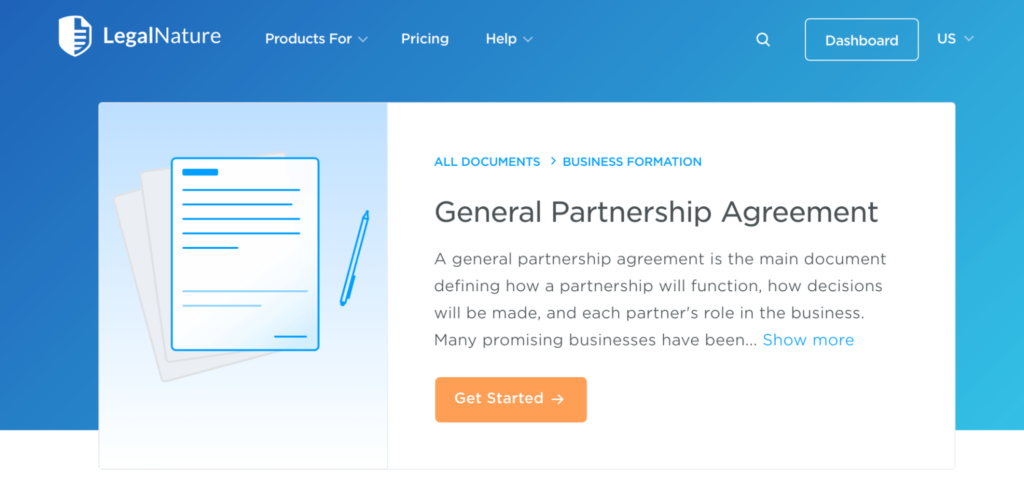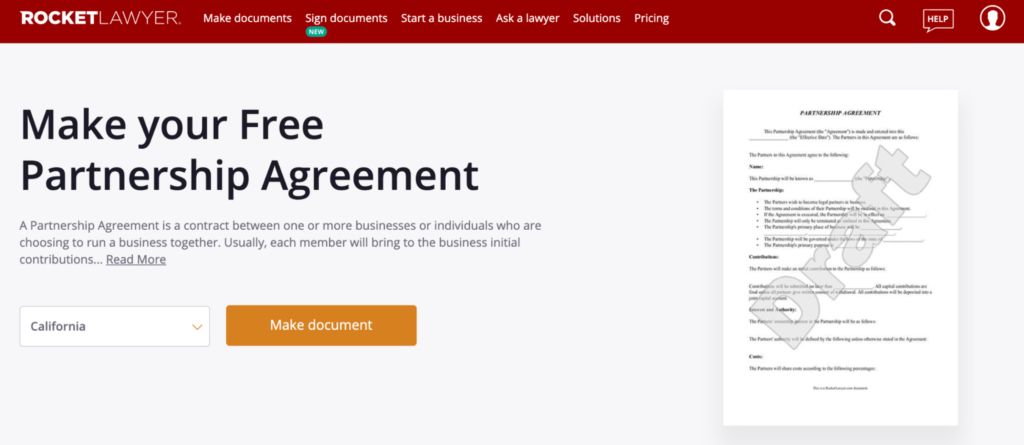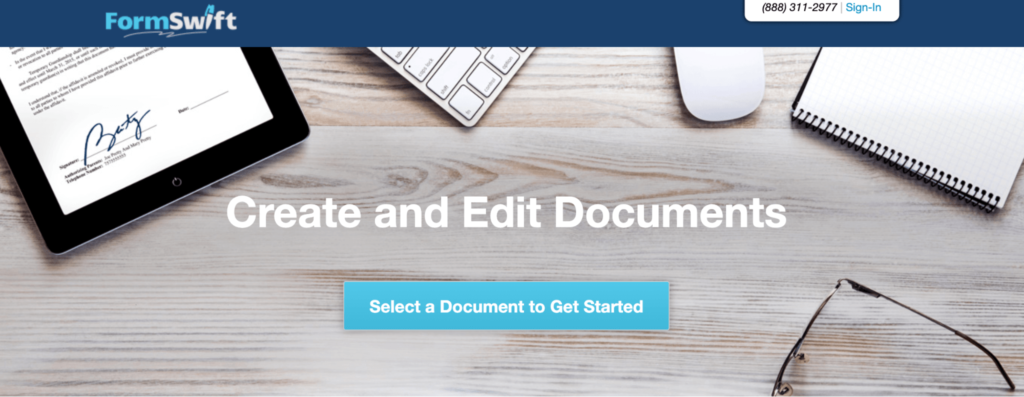If you’re going into business with one or more partners, you need to create a partnership agreement.
Even though these agreements aren’t legally required in a partnership, they can help establish clear rules for operating the business and define the roles for all partners. Partnership agreements bring clarity to any business relationship.
There can be ambiguity over who is responsible for certain aspects of the business and who is entitled to compensation without an official agreement. This can lead to disputes, lawsuits, and potentially end the personal relationship with your partners outside the company.
This guide will teach you how to create a business partnership agreement that’s legally binding.
What is a Business Partnership Agreement?
Partnership agreements are legal documents between two or more partners going into or who are already in business together. The document defines the business structure, capital contributions, ownership interest, decision-making authority, and other roles for each partner.
A partnership agreement will also spell out the process for a partner leaving the company, selling interest, and how the partners will split profits and losses.
The Basics of Business Partnership Agreements
Every business partnership will be a bit different, but the best partnership agreements will contain the following core components:
Type of Partnership
From a legal, liability, and taxation standpoint, there are several different types of partnerships to consider. Depending on the type you select, there might be some additional filings required for the state or IRS. But your partnership type should absolutely be named and defined in the partnership agreement.
Here’s a quick overview of the four main types of business partnerships:
- General Partnership (GP) — Two or more owners can form a general partnership where they share equal responsibility, authority, rights, liabilities, and debts. GPs offer pass-through taxation to business owners and don’t require a separate return.
- Limited Partnership (LP) — LPs restrict the amount of liability involved for investment partners. There will be at least one general partner who handles operations and assumes liability for the business. Limited partners, also known as silent partners, can only lose up to their initial investment amount, as long as they don’t take part in managing business operations.
- Limited Liability Partnership (LLP) — LLPs add liability protection to all partners. It has the same taxation as a general partnership but adds additional protections to each partner’s personal assets outside of the business.
- Limited Liability Limited Partnership (LLLP) — LLLPs have a combination of general partners and limited partners. This type of partnership is common for certain professions like doctors, lawyers, and accountants. Partners can be protected from errors and omissions liabilities based on the actions of other partners.
Not every state recognizes each type of partnership. So you need to understand your local laws before you finalize this part of the agreement.
Initial Contributions and Ownership Interest
Document how much money each partner contributes during the formation of the partnership. Often, initial contributions are directly tied to ownership stake, but that’s not always the case.
In some circumstances, the monetary contribution won’t come until after the partnership agreement has been drafted. So the agreement should also document when the initial contributions must be made.
Most partnership agreements include provisions for subsequent contributions, such as who will add additional capital if there is insufficient cash flow. These terms should be outlined.
You do not need equal contributions to be equal partners. You can create a partnership agreement spelling out 50/50 ownership partners even if the two people don’t contribute the same amount of money. For example, one partner might put up all of the capital, while the other partner’s contribution might be sweat equity.
Regardless of your unique scenario, the ownership interest percentages must be clearly stated in the agreement.
Partner Roles and Responsibilities
All partners must abide by the same basic legal responsibilities. This includes paying taxes and keeping accurate records. But not every partner will have the same role and authority.
If you’re starting a limited partnership, silent partners won’t have any say in the operational controls over the business. They simply contribute capital and collect profits or take losses.
These roles must be defined in the partnership agreement.
Even in general partnerships where each partner has equal authority, it’s in your best interest to split up the roles and responsibilities. For example, you can split up responsibilities for things like:
- Hiring and managing employees
- Marketing
- Client relationship development
- Managing financial objectives
- Day-to-day operational management
Some partners may want to focus on big-picture initiatives, while others focus on daily operational tasks. Think about how you will split up duties and responsibilities across the business.
Dispute Resolution
You won’t always see eye-to-eye with your partners. So it’s essential to address how you’ll handle potential issues that arise.
Dispute resolution provisions are crucial in partnerships with an even number of partners who both have the same ownership stake and authority. It’s a little bit easier with an odd number, as disputes could simply go to a majority vote.
Some partnerships name a neutral third-party advisor who can settle any disputes or deadlock votes. There are also some formal approaches like mediation and arbitration, but these tend to be more of a headache.
Addition of Partners
As your business grows, there might be new opportunities to add partners. Your initial partnership agreement should plan for this and outline the process.
For example, where will the ownership percentage of a new partner come from? Will it be split evenly between all existing partners, or will a majority stakeholder have to give up more than a minority stakeholder?
It’s also common for partnership agreements to limit the voting rights of new partners with less equity, so they can’t come in and take control over business decisions.
Exit Strategy and Dissolution
Partnership agreements should contain rules for how one or more partners can leave the business arrangement.
Can a partner resign at any time? How far in advance do they need to provide notice to other partners? Is there a penalty for exiting the partnership?
Partnerships between two parties typically dissolve automatically if one partner leaves.
There should be a section of the agreement outlining the full terms and scenarios that would dissolve the partnership. It’s important to consider business continuity and succession here as well.
For example, let’s say you have a partnership with four individuals. If one of the partners retires or dies, what happens to their shares? Can they be passed along to the partner’s spouse or children? Or will they be distributed between the remaining partners?
You also need to consider what happens to any assets like equipment, office space, and bank accounts in the event of a dissolution. If you don’t have these rules and provisions in your partnership agreement, your state’s law will become the default answer.
5 Tools For Business Partnership Agreements
Drafting a partnership agreement is much easier if you’re using a template or online tool. These solutions are a fast and easy way to create legally sound partnership agreements:
#1 — LegalNature

LegalNature is another popular legal document resource for businesses. The platform has legal documents for business formation, business management, human resources, and so much more. Within this endless sea of useful documents, you’ll find two different general partnership agreements—basic and comprehensive.
Regardless of which option you select, both agreements are legally binding. Just answer some simple questions about your partnership, the partners, business purpose, finances, and more. LegalNature will create the agreement as you’re answering these questions. Single documents start at $34.95. But if you plan to use LegalNature for multiple documents, the monthly subscription provides the best value, starting at $38.95 per month.
#2 — Rocket Lawyer

Rocket Lawyer provides online legal services and legal documents for businesses of all shapes and sizes. It’s an excellent resource for entrepreneurs who want a DIY solution for creating a partnership agreement. With Rocket Lawyer, you just need to answer a few simple questions, and the platform will automatically generate the document in minutes.
You can save your progress, download or print the document, and even use Rocket Lawyer for online signatures. So you and your partners can all sign the agreement from different locations. Single documents start at $39.99. But most people go with a premium subscription that includes unlimited documents and free attorney services—starting at $39.99 per month.
#3 — PandaDoc

PandaDoc is best known for its e-signature solutions and document workflow tools for businesses. The software is trusted by over 27,000 companies across a wide range of industries. But what makes PandaDoc unique compared to other e-sign solutions is its extensive library of business document templates.
There are 24 different templates in the partnership agreement category on PandaDoc. From simple partnership agreements to joint partnerships, restaurant partnerships, liquidation agreements, small business partnership agreements, and more, you can find whatever you need on this platform. Plans with template access start at $19 per month, and the platform supports unlimited e-signatures.
#4 — LegalZoom

LegalZoom is an excellent option for those of you who want to take your partnerships to the next level with a limited partnership (LP) or limited liability partnership (LLP). You can also use LegalZoom to form an LLC with your partners.
The Business Advisory plan from LegalZoom, starting at $31.25 per month, is perfect for anyone who wants legal assistance to guide them through the partnership agreement process. LegalZoom also has other services for partnerships, including DBAs, business licenses, EINs, and more.
#5 — FormSwift

More than 16 million documents have been created on FormSwift. It’s a simple online solution for personal legal forms, small business legal forms, tax forms, and more. Just select your state, and you can create a partnership agreement in minutes using FormSwift’s professional document builder.
The builder asks you a series of questions, and the agreement will automatically get filled in based on your answers. It covers everything from your business purpose to initial contributions, ownership interests, new partners, dissolution, and everything else that should be included in the agreement. FormSwift is 100% free—no sign-up required.
3 Tricks For Business Partnership Agreements
Drafting a partnership agreement can be a bit overwhelming, especially if it’s your first time going through this process. But these quick tips and best practices will help everything go smoothly.
Trick #1: Use a Partnership Agreement Template
Starting with a blank page for any legal document is intimidating. You probably won’t get the legal terminology right, and you’re likely to leave out essential sections of the agreement.
Using a template makes your life much easier. As you’ve seen from the tools listed above, there are great online resources for this. Many of these solutions offer legally binding contracts for partnership agreements.
Even as a complete beginner, all you need to do is answer some simple questions about your partnership online, and the document will get drafted for you. Then you just need to collect signatures from all partners to make it official.
Trick #2: Hold Regular Meetings
Communication is the key to success in any relationship, including business partnerships.
While meetings aren’t necessarily a requirement for partnerships, it’s important to schedule them on a regular basis. You could even include something in the agreement saying that all partners need to meet every month or every quarter, at a minimum.
These meetings help everyone share ideas and get things off of their chest. It’s more formal than picking up the phone or sending an email with a suggestion or complaint, and it gives everyone a chance to speak their minds.
Failure to meet regularly with partners can lead to some ugly disputes and animosity, which can ultimately be the downfall of any partnership.
Trick #3: Consult With an Attorney
As with any legal document, it’s always in your best interest to consult with an attorney before you sign and finalize things. Partners should each consult with their own lawyers, just so there’s no conflict of interest.
Your lawyer will have your best interest in mind from a legal and liability standpoint. They might suggest adding specific provisions that can protect you in the long run.
In some cases, the same platform you use for a partnership agreement template can also provide you with attorney consultations.
What to Do Next
Ready to draft your partnership agreement? Not so fast.
As mentioned above, you should always have an attorney review the document before you sign anything. You don’t have to use a traditional lawyer that will charge you outrageous fees for this. Instead, check out our guide of the best online legal services.
You can also use a legal business entity to form a partnership. If you’re interested in doing this or your lawyer recommends it, then review our best business formation services to get started.
from Quick Sprout https://ift.tt/38gAsYT
via IFTTT
